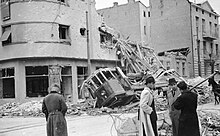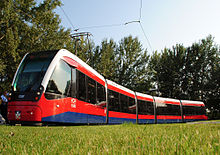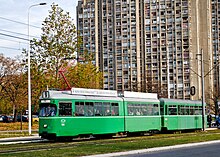Belgrade tram
| Belgrade tram | |
|---|---|
| Urbos-3 multiple units in Belgrade | |
| Basic information | |
| Country | Serbia |
| city | Belgrade |
| opening | October 14, 1892 |
| electrification | 1894 to 1904 |
| operator | GSP Beograd |
| Infrastructure | |
| Route length | 42 km |
| Gauge | 1000 mm ( meter gauge ) |
| Power system | 600 volt DC overhead line |
| business | |
| Lines | 9 |
| Belgrade tram network map | |
The Belgrade tram is a large tram system with twelve lines and a length of 127.3 kilometers . Around 200 trams operate in the Serbian capital Belgrade ( Serbian Београд Beograd ), including the types ČKD Tatra KT4 , CAF Urbos and the Duewag standard car Be 4/6 taken over from the Basel tram . The first horse-drawn railway line was opened in October 1892. At the beginning of the 21st century, the renewal of the entire track network began.
history
From 1892 to the First World War
On October 14, 1892, the first horse-drawn tram line was opened in Belgrade. It ran from Kalemegdan to Slavija. The first electric tram line opened in 1894. After 1894 there was no electrification or expansion of the tram network for almost ten years. It was not until 1903, when the work on building the tram network and electrical lighting was completed, that the electrification of the tram network also accelerated.
In 1904, electric trams replaced the horse-drawn trams on the Kalemegdan - Slavija and Kafana Žagubica (Inn) - Električna centrala lines, and in 1905, electric operation began on the Terazije - Novo groblje line . In addition to their function as public transport, horse-drawn trams in Belgrade were also the focus of public interest and their striking image remained with their contemporaries for a long time.
In 1912, twenty years after the introduction of tram traffic and seven years after the electrification of the last line, there were eight tram lines, on which an average of 24 railcars and 12 sidecars ran every day . This year 7.5 million passengers were carried.
Interwar period

The First World War and the occupation of Belgrade left the power station, the electricity network and, consequently, the tram traffic in a very poor condition. Soon after the city was liberated in 1919, the city administration took over the tram operation, which had previously been a private company. Most of the pre-war infrastructure and vehicle fleet was worn out. Until 1932 everything was gradually renewed.
At the end of 1932, Belgrade had 65.5 kilometers of tram lines, two-thirds of which were double-track and one-third was single-track. The following new routes were opened in 1931 and 1932: Knežev spomenik - Dedinje , Slavija - Dušanovac , Terazije - Pašino brdo and Smederevski drum - Cvetkova mehana - Prištinska street (today Cara Nikolaja II street).
In 1940 there were ten lines and a total of 103 trams. The tram system and the city were badly damaged during World War II . The bombing in 1941 destroyed 38 trams.
After the Second World War
After the Second World War, the tram system in Belgrade was continuously rebuilt, and the Belgrade trolleybus has been operating in the city since 1947 . In 1955, 162 trams ran on eight lines. In the 1970s, plans arose to build a subway . These were abandoned in 1982 when the city decided to expand the tram network instead. In 1985, the route network was expanded to 42 kilometers when the tram route across the Sava to Novi Beograd was opened.
Around 1990 the number of passengers on the tram peaked. This changed with the collapse of the former Yugoslavia . The sanctions against Serbia led to a dramatic cut in funding for the tram system. Investments in the purchase of new vehicles and spare parts as well as in the maintenance of the infrastructure were minimal. In 1996 and 1997, the tracks on Bulevar revolucije (now Bulevar Kralja Aleksandra) (between Cvetkova pijaca and Radio-industrija) as well as in Ruzveltova and Jurija Gagarina streets were renewed.
At the beginning of the 21st century, funding for local public transport increased as the country slowly recovered. In 2004 around 150 trams were in use. Extensive renovation work was announced towards the end of the 2000s. Between 2005 and 2010 the tracks were completely rebuilt and modernized in the following streets: Treci bulevar, Milentija Popovica, Savska, Nemanjina, Bulevar Kralja Aleksandra (from Vukov spomenik to Cvetkova pijaca ), Pozeska, Pariska, Bulevar vojvode Misica, Tadeuša Košćuškog. In addition, the tracks on the Autokomanda expressway were renewed and the old Sava Bridge renovated. This bridge is mainly used by tram lines that connect the two parts of Belgrade.
Lines
At the moment (2012) nine lines operate daily until around midnight. There is no continuous night traffic.
- Line 2 (ring line): Pristanište - Vukov Spomenik - Slavija - Pristanište
- Line 3: Kneževac - Rakovica - train station - Tašmajdan
- Line 5: Kalemegdan - Vukov spomenik - Ustanička
- Line 6: Tašmajdan - Vukov spomenik - Ustanička
- Line 7: Blok 45 - Novi Beograd - train station - Tašmajdan - Vukov spomenik - Ustanička
- Line 7L: Blok 45 - Novi Beograd - Train station - Tašmajdan
- Line 9L: Blok 45 - Novi Beograd - Railway Station - Slavija
- Line 12: Banovo brdo - train station - Slavija - Omladinski Stadium
- Line 13: Banovo brdo - train station - Blok 45
Former lines on today's network
These lines ran on the currently operated route network, they were discontinued at the beginning of the 21st century.
- Line 1: Kalemegdan - train station - Rakovica - Kneževac
- Line 4: Kalemegdan - Dorćol - Omladinski Stadium
- Line 8: Voždovac - Slavija - Omladinski Stadium
- Line 11: Blok 45 - Novi Beograd - Kalemegdan
vehicles
After the electrification of the tram, the old horse-drawn tram cars continued to be used as sidecars . In 1906, 16 electric railcars were available. In the period 1909/1919 10 motor coaches were purchased, so that the fleet then comprised 26 motor coaches and 12 trailer cars. After the end of the First World War, the now very worn pre-war cars were retired. In 1940 the Belgrade tram had 104 railcars and 60 sidecars. A year later, only 38 railcars and 36 sidecars were intact.
In 1955, the war damage had been repaired to such an extent that 155 trams were in use. The first tram car produced in Yugoslavia was the Gosa type, which was produced from 1956.
Used cars from Hagen
In 1977 ten GT6 (60-69) and all four-axle vehicles came from Hagen to Belgrade, as the local tram network had been discontinued the previous year.
Used cars from Basel
In 2001 Belgrade received used trams for the first time from the Basler Verkehrs-Betriebe . This transfer was financed and organized by the Swiss State Secretariat for Economic Affairs . The delivery in 2001 comprised 13 railcars, including twelve six-axle Duewag standard cars (603-606, 610, 615, 617-618, 621, 630, 632 and 640) and a four-axle Swiss standard car (456). There were also nine three-axle (1335-1340, 1342-1344) and twelve four-axle sidecars (1401-1403, 1405-1407, 1409-1413, 1415). In 2002, another eleven Duewag standard cars came to Belgrade (607-609, 611-614, 616, 619-620 and 622), in 2003 another three (625, 631 and 657), in 2009 three more (634, 648 and 649) and 2011 one (654). In addition, in 2006 another four (1423-1426) and again four sidecars in 2011 (1429, 1431-1432 and 1438). By 2011, a total of 31 railcars and 29 sidecars came from BVB to the Belgrade tram.
In 2012, wagons from Baselland Transport AG (BLT) followed for the first time , these were the six Duewag standard wagons 123, 133, 135, 141, 143 and 158 as well as the six four-axle sidecars 1316–1321.
Tatra T4
Tatra KT 4
CAF Urbos 3
In 2009, a contract was with the Spanish manufacturers Construcciones y Auxiliar de Ferrocarriles (CAF) for the delivery of 30 five-part low-floor - articulated railcar of the type URBOS 3 completed. The lanes are completely low-floor, 33 meters long and 2.3 meters wide. One car can accommodate up to 242 passengers. The order has a volume of 70 million euros. The first Urbos 3 was delivered in May 2011.
See also
Web links
- Official website of the operator GSP Beograd
- Network maps on BelgradeMaps.com
- Network map on urbanrail.net
Individual evidence
- ↑ Beograd to buy 30 CAF trams . Railway Gazette International . November 6, 2009. Retrieved April 1, 2011.
- ↑ Observer: Tracks to be purchased for reconstruction of tram system . July 29, 2006. Retrieved September 12, 2009.
- ↑ Important Years in City History . City of Belgrade. Retrieved October 28, 2009.














